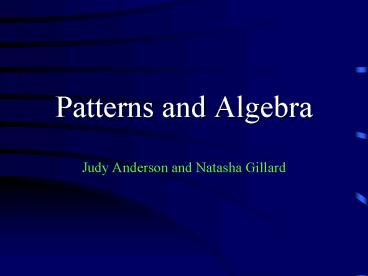Patterns and Algebra - PowerPoint PPT Presentation
1 / 20
Title:
Patterns and Algebra
Description:
when I count by fives the last number goes five, zero, five, zero, ... Five outcomes at this Stage: use letters to represent numbers ... – PowerPoint PPT presentation
Number of Views:1429
Avg rating:3.0/5.0
Title: Patterns and Algebra
1
Patterns and Algebra
- Judy Anderson and Natasha Gillard
2
Workshop Overview
- Introduction to Patterns and Algebra
- Key Ideas for each Stage
- Sample Activities
3
Introduction to Patterns and Algebra
- one of six strands
- extends from Early Stage 1 to Stage 5 (and
beyond) - incorporates Repeating Patterns, Number Patterns
and Number Relationships
4
Why is it a separate Strand ?
- Patterns and Algebra concepts are currently
contained in the Number and Space Strands - why have separate outcomes and detailed content?
- - to emphasise its importance
- - to show that the development of
pre-algebra concepts begin in ES1 - - to show the development of concepts across
the continuum
5
Why is it called Patterns and Algebra ?
- to show the connections between early number
patterns and number relationships and the more
formal algebra concepts - Patterns and Algebra does not include pattern
making (this remains part of Space and Geometry)
6
Scope and Continuum of Key Ideas- handout
- shows the development of concepts across the
Stages - a sound arithmetic foundation is required for the
learning of algebra - Patterns and Algebra should be taught in
conjunction with Number concepts
7
Key Ideas for each Stage
- Early Stage 1
- recognise, describe, create and continue
repeating patterns
This is a three pattern
A B C A B C A B C
1 2 3 1 2 3 1 2 3
These are all three patterns
8
- continue simple number patterns that increase or
decrease
- use the term is the same as to describe
equality of groups
9
- Stage 1
- create, represent and continue a variety of
number patterns and supply missing elements
10
- build number relationships (addition and
subtraction facts to at least 20)
11
- make generalisations about number relationships
When I add zero it does not change the number
when I count by fives the last number goes five,
zero, five, zero,
An odd number plus an odd number always equals an
even number
12
- use the equals sign to record equivalent number
relationships
13
- Stage 2
- generate, describe and record number patterns
using a variety of strategies
- 1, 4, 7, 10,
- 2.2, 2.0, 1.8, 1.6,
- 2 3 4 5 6 7
- 4, 4, 4, 4, 4, 4, 4,
(generate using calculator, materials or mental
strategies)
14
- build number relationships (relating
multiplication and division facts to at least 10
x 10)
2 x 4 4 x 2 (applying the commutative
property)
The multiplication facts for 6 are double the
multiplication facts for 3
6x4 24 so 244 6 and 246 4.
(describing the relationships)
(relating multiplication and division)
15
- complete simple number sentences by
calculating the value of a missing number
16
- Stage 3 - algebra without symbols
- build simple geometric patterns involving
multiples
17
- complete a table of values for geometric and
number patterns
18
- describe a pattern in words in more than one way
(determining a rule to describe the pattern from
the table)
It looks like the 3 times tables.
You multiply the top number by three to get the
bottom number.
19
- construct, verify and complete number
sentences involving the four operations with a
variety of numbers
- completing number sentences
- 5 12 4
- 7 x 7.7
- constructing number sentences to match a word
problem - checking solutions and describing strategies
20
Stage 4 - algebra with symbols
- Five outcomes at this Stage
- use letters to represent numbers
- describe number patterns with symbols
- simplify, expand and factorise algebraic
expressions - solve equations and simple inequalities
- graph on the number plane































